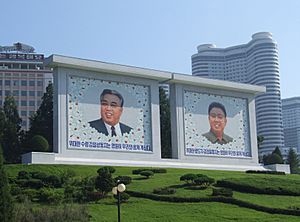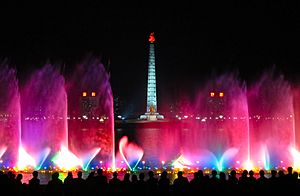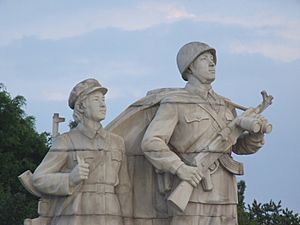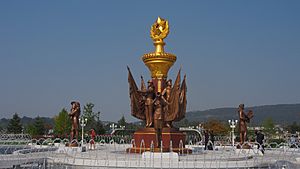Kim Il-Sung facts for kids
Quick facts for kids
Kim Il-sung
|
|
|---|---|
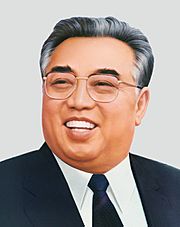
Official portrait (posthumous, issued 1994)
|
|
| Eternal President of the Republic (Appellation) | |
| Assumed office 8 July 1994 |
|
| Supreme Leader of North Korea | |
| In office 9 September 1948 – 8 July 1994 |
|
| Succeeded by | Kim Jong-il |
| President of North Korea | |
| In office 28 December 1972 – 8 July 1994 |
|
| Preceded by | Position created Choi Yong-kun, Head of State as President of the Presidium of the Supreme People's Assembly |
| Succeeded by | Position abolished (Proclaimed Eternal President of the Republic after his death) |
| Prime Minister of North Korea | |
| In office 9 September 1948 – 28 December 1972 |
|
| Preceded by | Position created |
| Succeeded by | Kim Il (Premier) |
| General Secretary of the Central Committee of the Workers' Party of Korea | |
| In office 11 October 1966 – 8 July 1994 |
|
| Preceded by | Himself as Chairman |
| Succeeded by | Kim Jong-il |
| Chairman of the Central Committee of the Workers Party of Korea | |
| In office 30 June 1949 – 11 October 1966 |
|
| Preceded by | Kim Tu-bong |
| Succeeded by | Himself as General Secretary |
| Vice-Chairman of the Central Committee of the Workers’ Party of North Korea | |
| In office 28 August 1946 – 30 June 1949 |
|
| Chairman | Kim Tu-bong |
| Preceded by | Position created |
| Succeeded by | Position abolished |
| Chairman of the North Korea Bureau of the Communist Party of Korea | |
| In office 17 December 1945 – 28 August 1946 |
|
| General Secretary | Pak Hon-yong |
| Preceded by | Kim Yong-bom |
| Succeeded by | Position abolished |
| Personal details | |
| Born |
Kim Sŏng-ju
15 April 1912 Mangyŏngdae, Heian-nandō, Japanese Korea |
| Died | 8 July 1994 (aged 82) Pyongyang, Democratic People's Republic of Korea |
| Resting place | Kumsusan Palace of the Sun, Pyongyang, Democratic People's Republic of Korea |
| Nationality | North Korean |
| Political party | Workers’ Party of Korea |
| Spouses | Kim Jong-suk (d. 1949) Kim Song-ae |
| Children | Kim Jong-il Kim Man-il Kim Kyong-hui Kim Kyong-jin Kim Pyong-il Kim Yong-il |
| Residences | Pyongyang, Democratic People's Republic of Korea |
| Occupation | Eternal President of the Republic |
| Profession | President of North Korea |
| Signature | |
| Military service | |
| Allegiance | |
| Branch/service | Soviet Armed Forces Korean People's Army |
| Years of service | 1941–1945 1948–1994 |
| Rank | Dae wonsu (Grand Marshal) |
| Commands | All (supreme commander) |
| Battles/wars | World War II Korean War |
Kim Il-sung (born April 15, 1912 – died July 8, 1994) was the first leader of North Korea. He led the country from 1948 until his death in 1994. He had complete control over North Korea.
Kim Il-sung died from a heart attack on July 8, 1994. People in North Korea still call him the 'Eternal Leader'. His name, Kim Il-sung, means "become the sun".
He created a political idea called Juche. This idea meant North Korea would run itself differently from the Soviet Union and China. There are over 300 statues of Kim Il-sung in North Korea.
After he died, his son Kim Jong-il (1941-2011) became the next leader. He led until his death on December 17, 2011. Now, Kim Il-sung's grandson, Kim Jong Un, is the current leader of North Korea.
Contents
Founding North Korea
In 1945, World War II ended. The Soviet Union declared war on Japan. The United States dropped atomic bombs on Japan. This greatly weakened the Japanese Empire.
The Soviet Red Army entered Japanese-controlled Korea. They easily captured the city of Pyongyang. The Soviets made Kim Il-sung the leader of the North Korean branch of the Korean Communist Party. They gave him modern tanks, trucks, and weapons for the Korean People's Army (KPA).
The Democratic People's Republic of Korea (DPRK) was officially created on September 8, 1948. This happened despite the United Nations (UN) not agreeing. Soviet leader Joseph Stalin helped Kim become the leader of this new state.
The southern part of the Korean Peninsula then formed its own country. It became the Republic of Korea (South Korea). Statues of Kim Il-sung started appearing in North Korea as early as 1949.
Kim Il-sung as Leader
In its early years, North Korea was doing better economically than South Korea. This was mainly because of help from the Soviet Union and China. Kim Il-sung set up a centrally-planned economy. This meant the government controlled all production. Food prices were fixed and did not change based on supply and demand.
Kim Il-sung officially became the President of North Korea in 1972. This was stated in the country's new constitution.
The Korean War
The Soviet Union believed Kim's government should rule all of Korea. It is thought that Kim decided to invade South Korea on his own. The Soviets did not force him.
On June 25, 1950, Kim's army invaded the South very early in the morning. South Korea was completely surprised. The KPA quickly captured Seoul and most of the South. Only a small area around Pusan in the southeast remained free.
United Nations forces, mostly from the United States, arrived in Korea. They began to push the KPA back north. First, they pushed the KPA past the 38th parallel. This was the imaginary line that divided the Koreas.
China was at first unsure about uniting Korea under Kim's rule. But they agreed when Kim told them that Stalin approved the invasion.
The UN voted on whether its forces should try to unite Korea under a democratic government. The vote passed because the Soviet Union was not there to veto it. If the Soviets had said no, UN forces could not have gone further into Korea.
Eventually, UN forces captured Pyongyang. Kim's government had to escape north across the Yalu River into China. The Chinese army then joined the fight. They crossed the Yalu River and fought alongside the KPA and the Red Army. They fought against the US, British, and UN forces.
The war reached a point where neither side could win completely. An agreement to stop fighting, called an armistice, was signed on July 27, 1953. This ended three years of fighting. It also created the two separate nations of North Korea and South Korea. Since no peace treaty was ever signed, the two Koreas are still technically at war.
Cult of Personality
A "cult of personality" is when a leader is made to seem like a god or a perfect hero. This happened with Kim Il-sung.
In 1982, for Kim Il-sung's 70th birthday, a 170-meter tall tower was built. It was called the Juche Tower. It was made of 25,550 stone blocks. This was one block for each day of Kim's life.
It is a rule in North Korea that every home must have a portrait of Kim Il-sung. A portrait of his son, Kim Jong-il, must also be there. Everyone is given a special cloth to clean these portraits daily.
In the 1980s, Kim Il-sung developed a lump on the back of his neck. It grew to the size of an orange. Doctors decided it was too risky to remove it because it was too close to his spine. Because of this, North Korean reporters were not allowed to photograph Kim Il-sung from his right side.
In 1997, North Korea stopped using the regular calendar used worldwide. Instead, they started using the Juche calendar. This calendar begins with the year of Kim Il-sung's birth (1912) as year 1. For example, 2015 is written as Juche 104. To find the Juche year, you subtract 1911 from the current year. Dates in North Korea often start with Juche; for example: April 12, Juche 104 (2015).
Later Years and Death
In the early 1990s, North Korea faced a severe food shortage, known as the Great Famine. At the same time, the Soviet Union was having big economic problems. The Soviets had given North Korea food and other supplies since the 1940s. But now, they started asking North Korea to pay them back. North Korea did not have the money.
The Soviet Union collapsed in 1991. After this, food aid to North Korea stopped almost immediately. Kim Il-sung's centrally planned economic system was not flexible enough to handle this disaster.
On July 8, 1994, Kim Il-sung had a heart attack and died. He left his country in a very difficult situation. North Korea was bankrupt, many people were malnourished, and the country was isolated from much of the world.
A period of mourning was announced after his death. It officially ended in 1997, three years later. His son, Kim Jong-il, who had been prepared to take over, became the new supreme leader. Kim Jong-il did not become President. This is because Kim Il-sung was given the special title of Eternal President.
So, North Korea is the only country in the world that is technically led by a dead person. State propaganda made Kim Il-sung seem like a god to the people. When he died, many people felt lost and confused. This was because they believed he could not die.
Images for kids
-
Kim Il-sung (centre) and Kim Tu-bong (second from right) at the joint meeting of the New People's Party and the Workers' Party of North Korea in Pyongyang, 28 August 1946
-
Kim Il-sung and Peng Dehuai in 1951
-
Kim on a 1956 visit to East Germany, chatting with painter Otto Nagel and Prime Minister Otto Grotewohl
-
Kim greets visiting Romanian President Nicolae Ceaușescu in Pyongyang, 1971
-
Kim Il-sung's calcium deposit tumor is noticeable on the back of his head in this rare newsreel still image during a diplomatic meeting between him and Chinese Communist Party Chairman Mao Zedong in Beijing, 1970.
-
Kim's first wife, Kim Jŏng Suk, and his son, Kim Jong-il
See also
 In Spanish: Kim Il-sung para niños
In Spanish: Kim Il-sung para niños




